NAVAJO CHURRO SHEEP AND WOOL 5
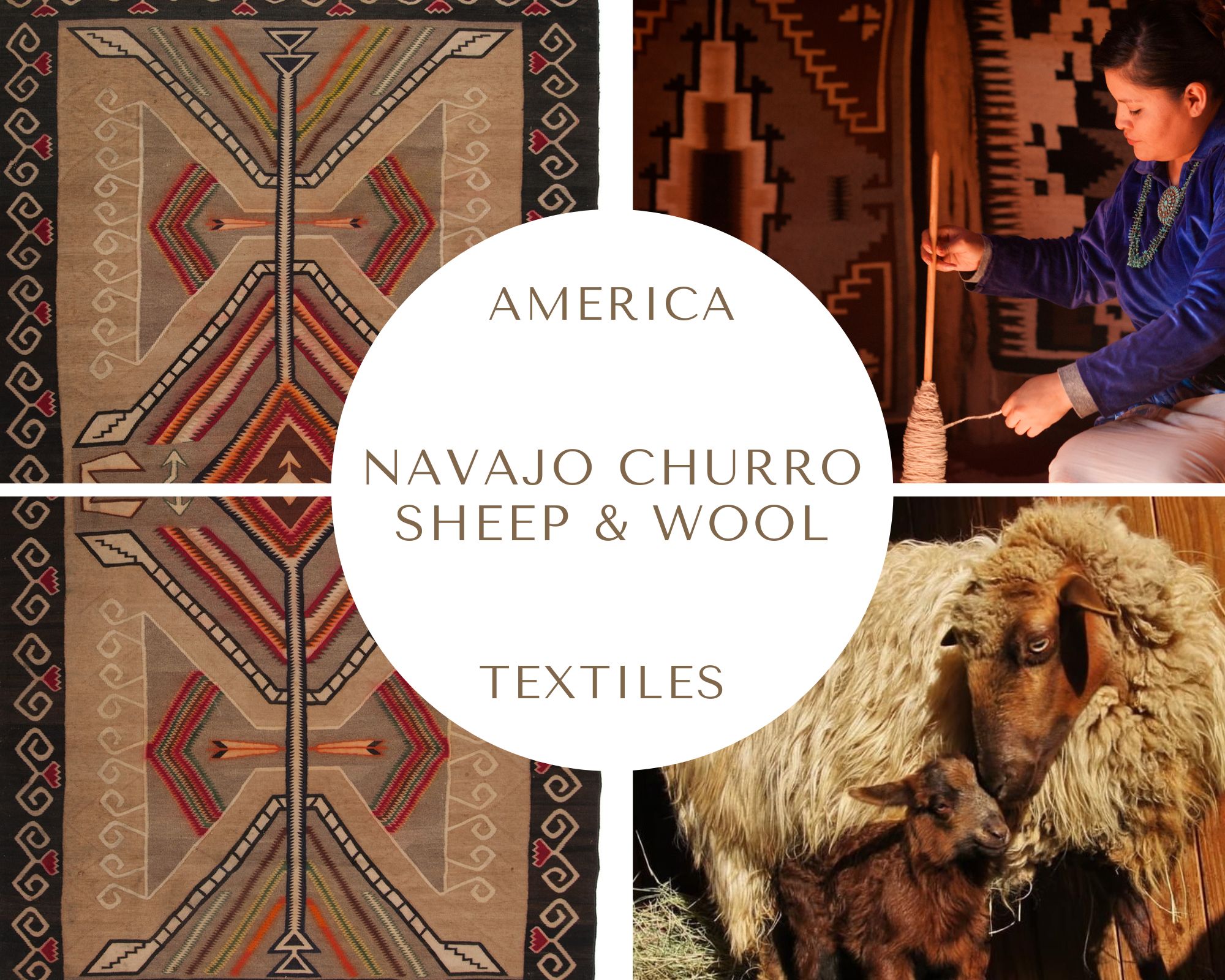
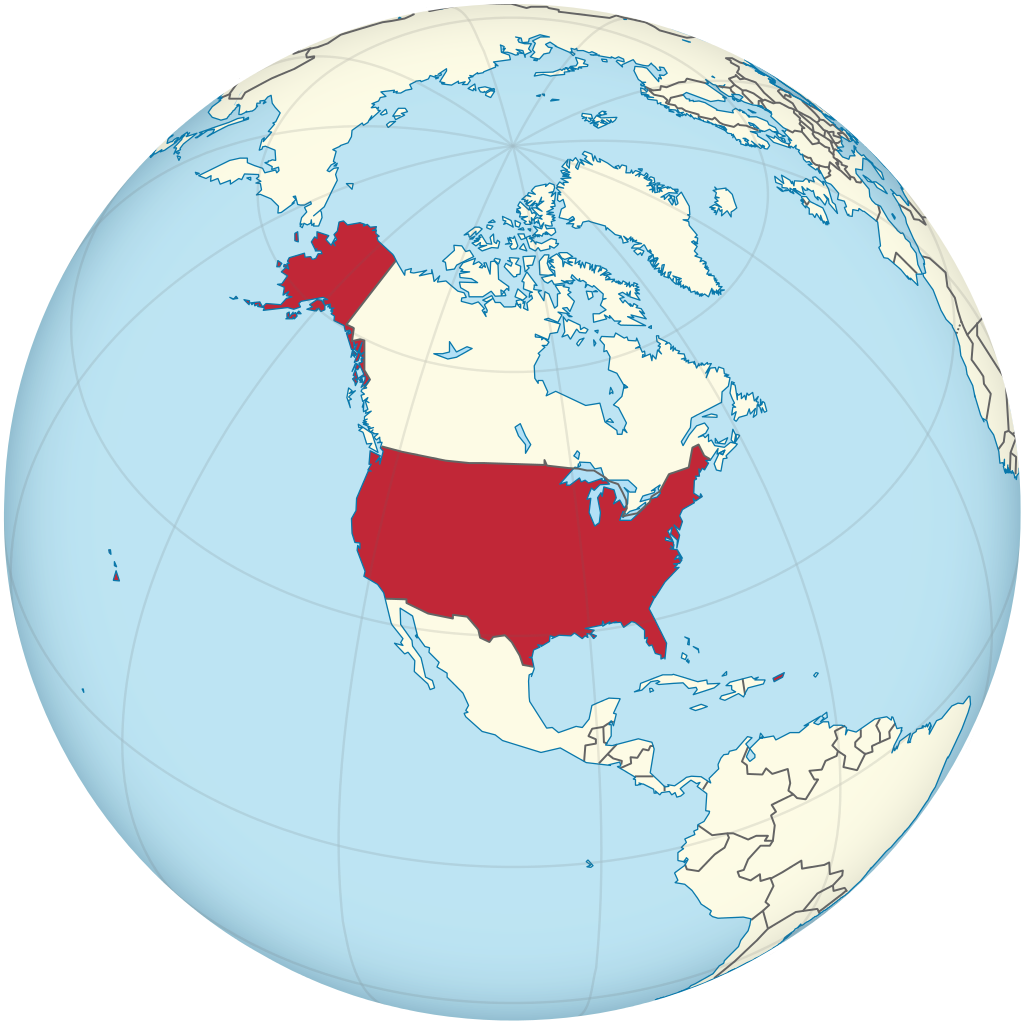
USA on the globe.
Licensed under the Creative Commons Attribution-Share Alike 3.0 Unported.
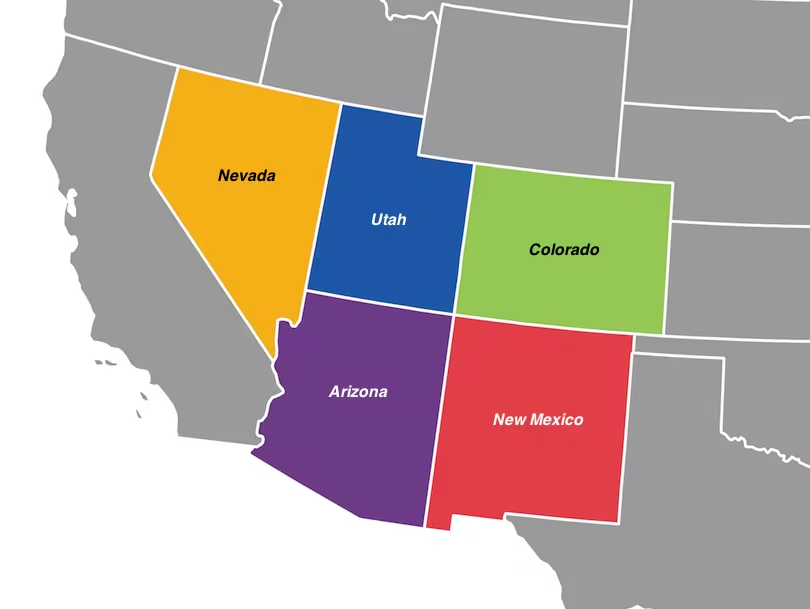
SOUTHWESTERN STATES
WOVEN LEGACIES: THE ART AND HISTORY OF NAVAJO/DINÉ TEXTILES
The intricate craft of Navajo (Diné) weaving is one of the deepest and most enduring artistic traditions of Native North America. Rooted in centuries of cultural knowledge, these textiles embody stories of resilience, adaptation, and creative mastery. In the chapters that follow, we will explore the evolution, diverse forms, and timeless beauty of this remarkable art form.
-
THE EVOLUTION OF NAVAJO/DINÉ TEXTILES FROM SIMPLE BLANKETS TO COMPLEX WEAVINGS
Origins and Early Development
The Navajo people first learned to weave from their Pueblo neighbors around the late 17th century, adopting techniques that originally used cotton. The original function of Navajo weaving was utilitarian, producing clothing items such as shoulder robes, rectangular panel or wrap dresses, semi-tailored shirts, breechcloths, and a variety of belts, sashes, hair ties, and garters. Prior to European contact, these textiles were primarily for Navajo use and occasional trade with other Native American tribes.
A crucial development occurred when the Spanish introduced Iberian Churra sheep to the Southwest, which the Navajo developed into their own Navajo Churro breed, producing wool ideal for weaving.
Early Navajo wool textiles featured simple striped patterns of natural, undyed yarns that were heavily influenced by Pueblo designs. These early weavings were primarily utilitarian, serving multiple purposes in daily life. There were several types of early textiles. The most common were blankets. They had horizontal stripes using natural wool colors (white, brown, gray) plus indigo-dyed blue and red from unraveled trade cloth called bayeta. (The Navajos unraveled the imported red cloth into threads, sometimes recarding and respinning it; then they wove it to create a new vibrant color in their blankets. This type of unraveled wool yarn is the bayeta).
Weavers often embellished these stripes with stepped geometric motifs or serrated diamond shapes adapted from Spanish and Mexican textiles. There were several types of blankets.
- Serapes (Shoulder Blankets) - Woven longer than they were wide and created vertically on the loom, they served as primary garments.
- Chief's Blankets - These prestige items were woven horizontally (wider than long) with patterns designed for horizontal display. By the mid-19th century, they had become highly valued trade items among the Native peoples of the Great Plains.
- Saddle Blankets: Developed as smaller, more square textiles to protect horses' backs, these came in single and double varieties. Double saddle blankets were folded in half before use to provide additional protection.
Serape blankets and Chief's blankets represent two different traditional Navajo weaving forms, each with unique characteristics in their design, orientation, and cultural significance.
The most fundamental difference between these two blanket types is the orientation of the weave:
- Serape blankets are woven vertically on the loom and are longer than they are wide (or narrower than they are tall).
- Chief's blankets are woven horizontally on the loom and are wider than they are long.
This difference in orientation can be seen by examining the direction of the warp threads in the fabric.
Cultural origin and design patterns also help distinguish these two blanket types:
- Serapes are more influenced by Mexican ponchos and typically feature stepped diamonds and stepped zigzag lines that create visual energy. They had more aggressive and imposing designs, with larger, more dominant diamond patterns.
- Chief's blankets had more restrained designs, especially in the early phases. They evolved from Pueblo wearing blankets with a distinct Navajo development through the three phases:
- First Phase (1700-1830s): Simple horizontal bands of natural brown/black and white with indigo blue or red stripes.
- Second Phase (1840-1860): Added 12 rectangular elements to the horizontal bands.
- Third Phase (1860-1868): Featured a "9-spot" design with serrated or terraced diamonds or triangles superimposed on the bands.
Both blankets were worn wrapped around the shoulders, but they served slightly different purposes:
- Chief's Blankets became highly valued trade items throughout the Southwest and Plains, often worn by people of high status.
- Serapes were primarily men's clothing in everyday Navajo life, but were often too delicate for rough use such as horseback riding.

Serape Blankets
In Navajo (Diné) culture, a serape (from the Spanish sarape or zarape) is a significant form of traditional weaving known as awos beeldléí in the Navajo language, meaning "shoulder blanket". These are long, rectangular textiles woven vertically on the loom that were designed to wrap around the wearer's shoulders, rather than being pulled over the head like other garments.
Serapes emerged primarily between 1840-1860, with later examples from 1865-1880 (the "late classic period") featuring more complex designs. They were typically woven in simple color palettes of red, white, and blue, with yellow and green accents, though later designs incorporated more vibrant colors and intricate patterns.
These blankets derive influence from Mexican ponchos, specifically the Saltillo blanket from Aztec culture. While they were worn by both men and women in everyday life, they were primarily men's garments. Unlike their Mexican counterparts that were sturdy enough for horseback riding, Navajo serapes were often too delicate for such rough use.
The craftsmanship of serapes represents the spiritual and artistic tradition of Navajo weaving. As expressed in the Navajo weaver's song, "with beauty, it is woven". The creation of these textiles was labor-intensive, with an estimated 345 hours required to complete a single blanket, from sheering sheep to the final weaving.
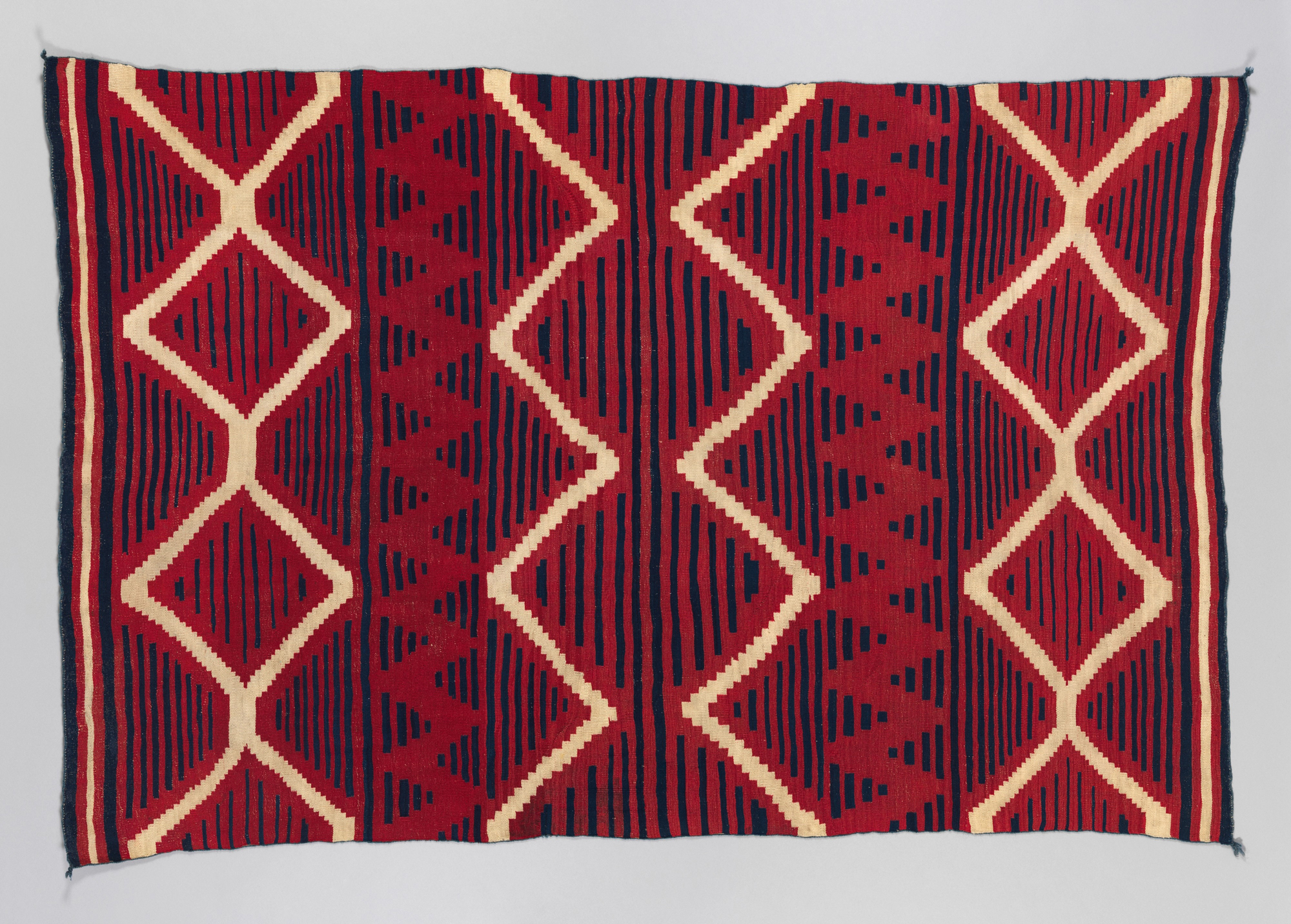
Large-sized Serape by an unidentified Navajo artist; ca. 1840–50. Medium: wool. Dimensions: 49 1/2 × 73 1/2 in. (123.2 × 186.7 cm). The American Wing of the MET Museum, New York, USA.
«Vibrantly colored and vividly patterned, these so-called wearing blankets build on long-established design themes. The horizontal lines and diamond shapes of this classic example—referred to by some as a rare "radio-wave" pattern—are characteristic of Southwest Native American design, reflecting varied weaving traditions and artistic exchange among Native and Hispanic communities.» (The MET Museum curators).
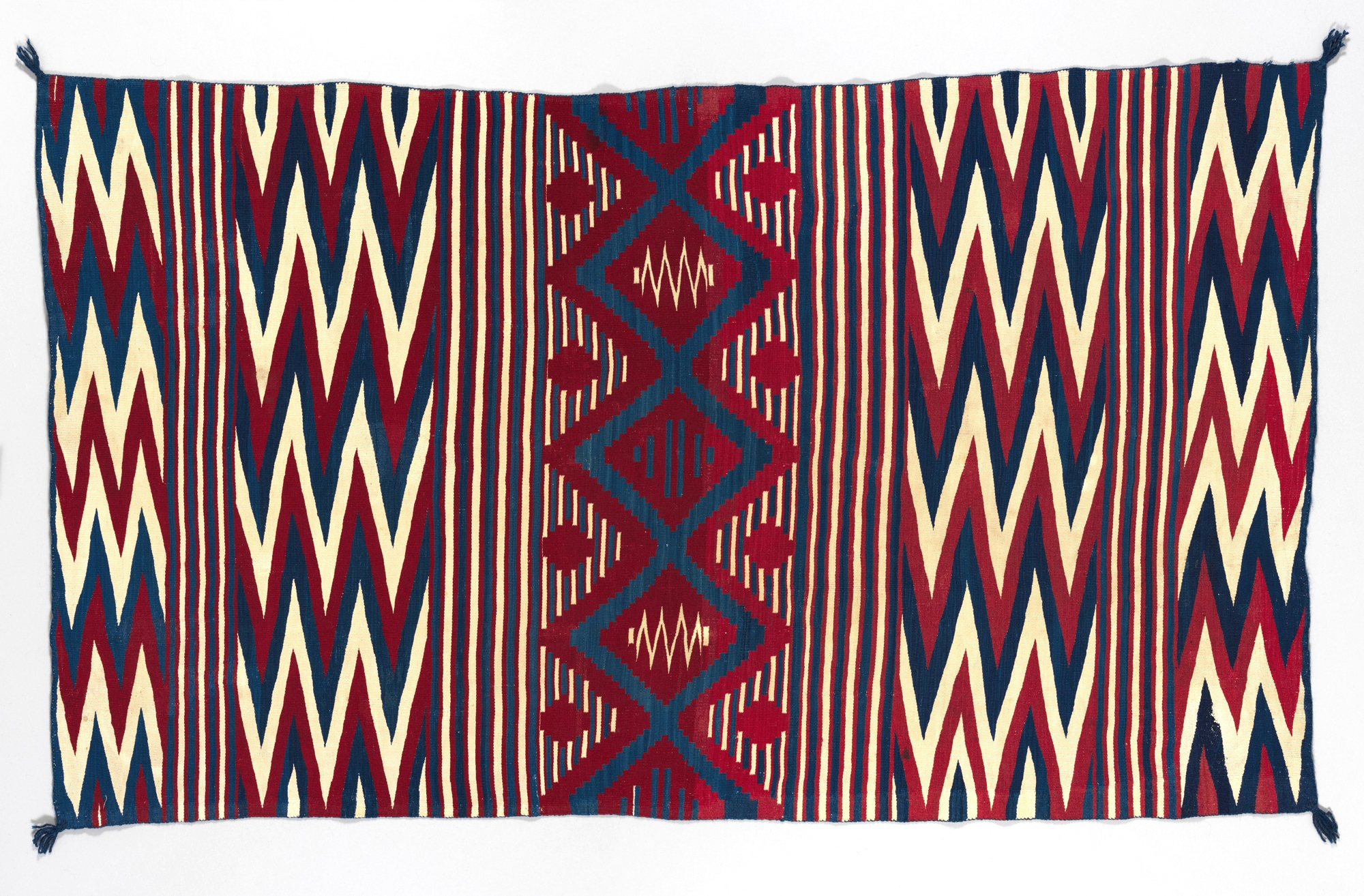
Large-sized Serape by an unidentified Navajo artist; ca. 1865. Medium: wool. Dimensions: 43 1/2 × 68 in. (110.5 × 172.7 cm). The American Wing of the MET Museum, New York, USA.
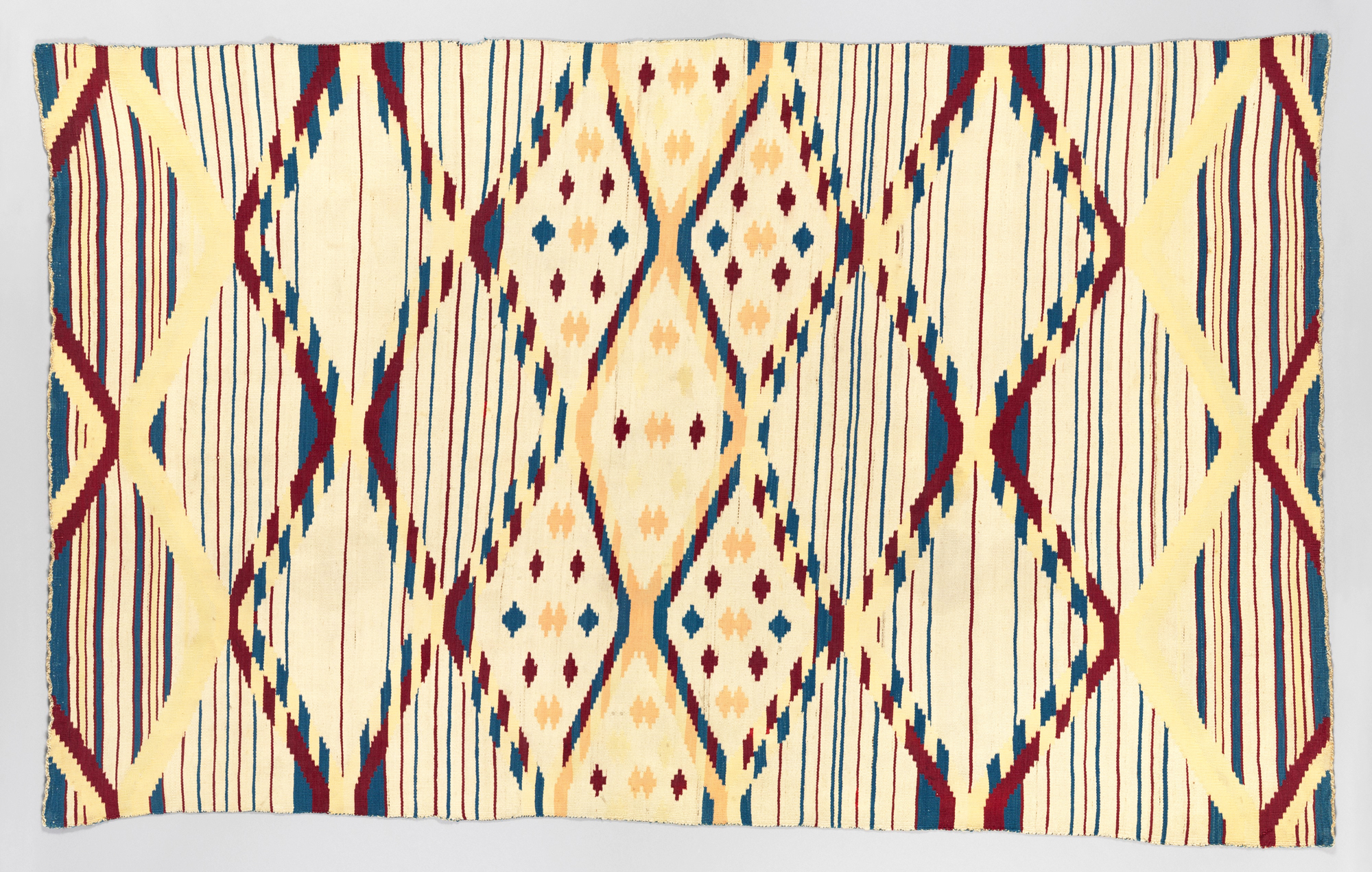
Large-sized Serape by an unidentified Navajo artist; ca. 1865–70. Medium: Dyed and undyed wool. Dimensions: 52 1/2 × 84 1/4 in. (133.4 × 210.8 cm). The American Wing of the MET Museum, New York, USA.
«Contemporary Native artists and scholars have identified this large weaving, with its unusual white background, as a "not- of-free-will" blanket—meaning it was likely produced by a highly skilled Navajo woman enslaved in a Spanish American household. An 1865 congressional report estimated that there were between 1,500 and 3,000 Navajo captives living in the Rio Grande Valley as well as in northern Mexico in these years. While this particular form of enslavement largely ended in the late 1870s, its traumatic legacy continues to reverberate today.» (The MET Museum curators).
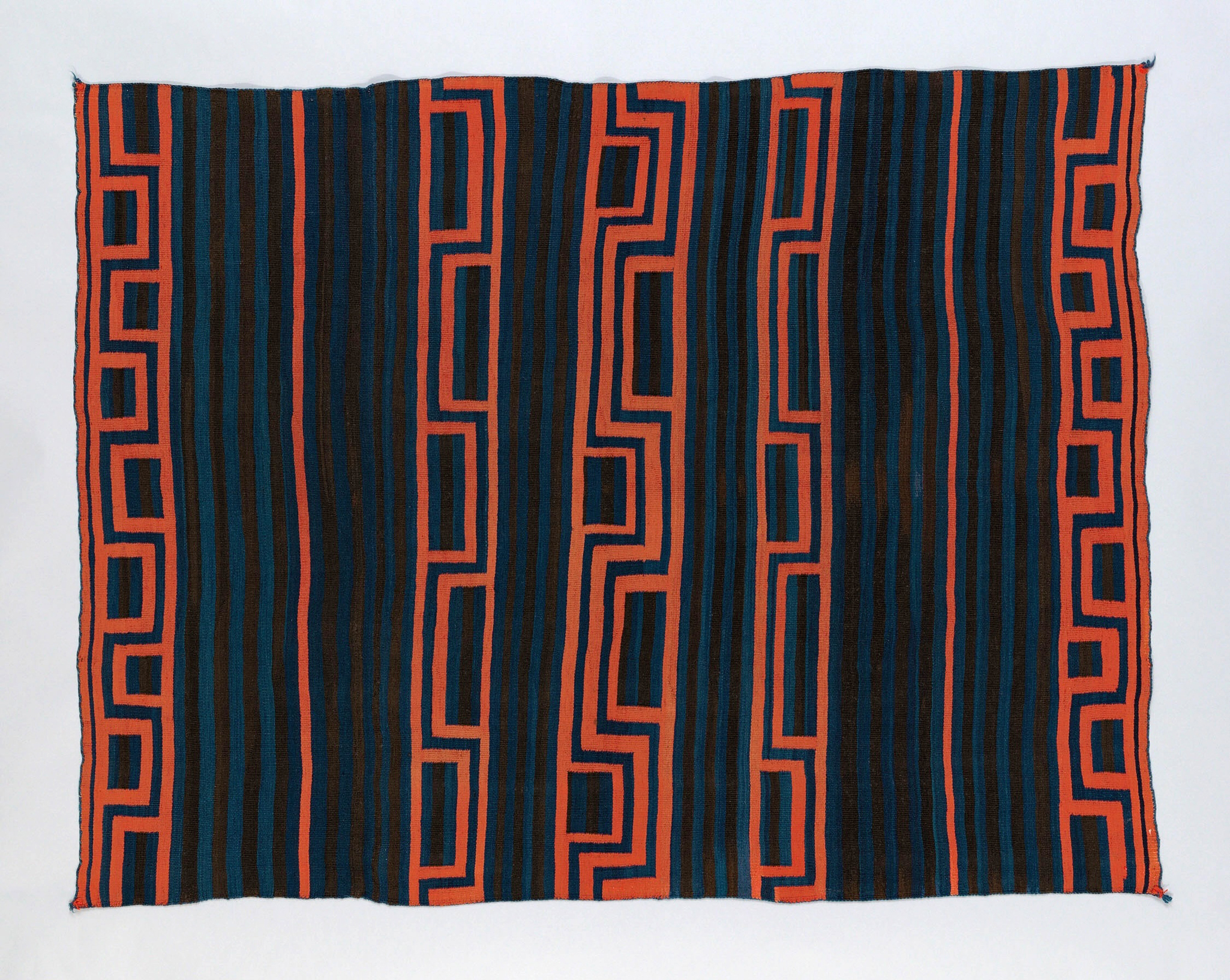
Moqui-Style Serape with Compound Banded Design, ca. 1865-75, New Mexico. Medium: Wool, single interlocking tapestry weave; two selvages present. Dimensions: 174 × 132.2 cm (68 1/2 × 52 in.). Art Institute of Chicago, Illinois, USA.
« The Spanish-derived word sarape is used to identify blankets made throughout the greater Southwest and Mexico that are longe then they are wide and traditionally are worn around the shoulders like a shawl. This exceptionally fine example displays many attributes associated with classic Navajo textiles, including its traditional tapestry weave, the augmented tassels placed at the corners, and the twining that appears along the edges. The design is based upon Moki-style textiles, which were typically woven with alternating blue-and-brown lines often accented with additional bands of white. Although the name given to this style derives from the Spanish term for the Hopi (Moki or Moqui), these patterns found favor among Pueblo and Navajo weavers and are one of the oldest designs that appear in Navajo textiles. Demonstrating the creativity and cultural identity of the artist, this sarape blends Moki design traits with a distinctly Navajo signature—that of bold crimson banding superimposed over the subtle striping.» (Art Institute Chicago curators).
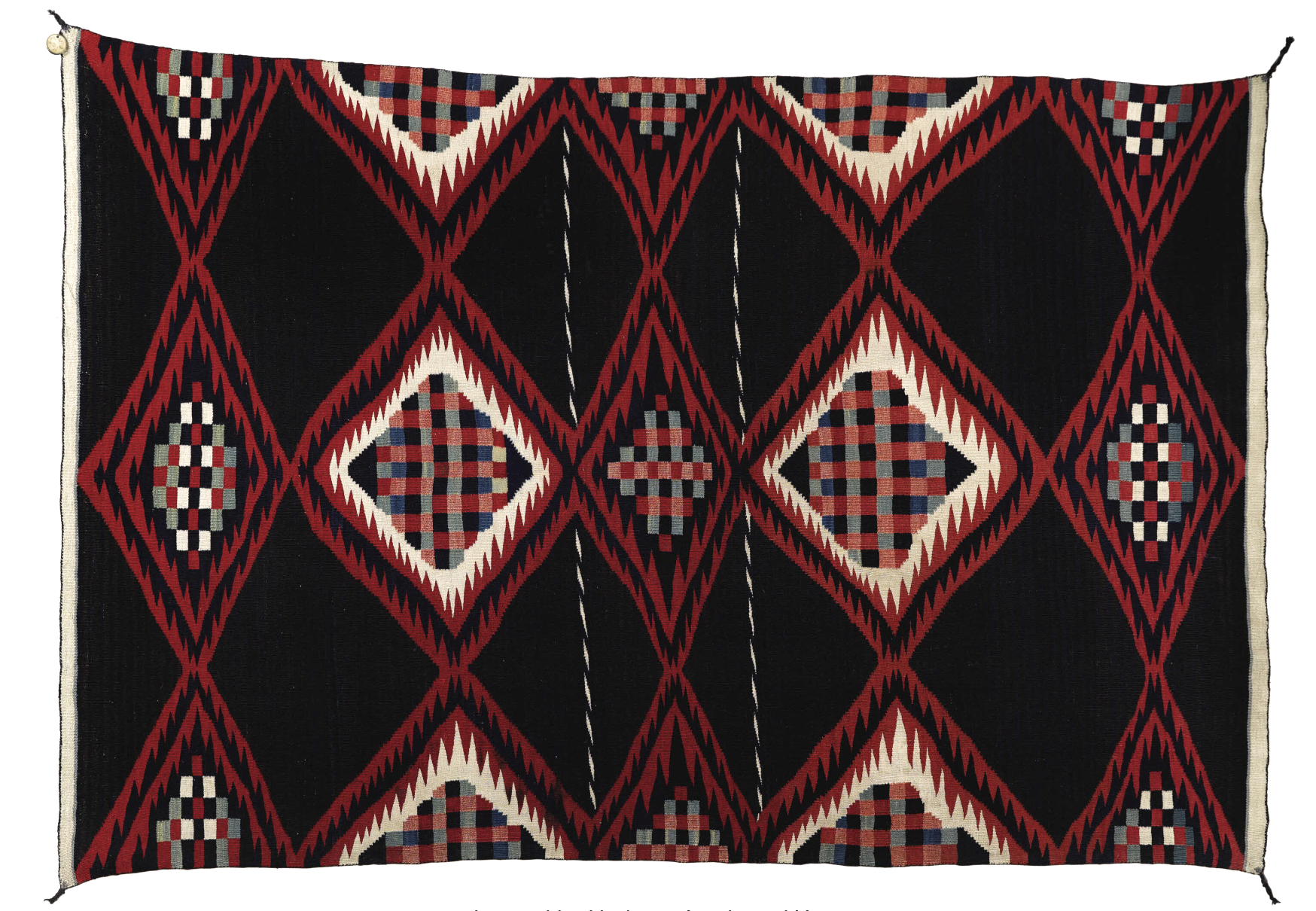
Classic Navajo Moqui-Style Man's Serape from the Fred Harvey Collection. Ca. 1870. Length 73 1/2 in; width 53 in. Photo courtesy by Heritage Auctions, Dallas, Texas, USA.
The yarns in this weave: The dark reds are raveled bayeta, dyed with a combination of lac and cochineal, 5% lac and 95% cochineal (dye analysis provided by David Wenger, Ph.D.); the pinks are the same raveled bayeta, recarded and respun with white to make pink; the blues are hand spun and dyed with indigo; the whites and browns are undyed hand spun; and the green is hand spun and dyed with combinations of indigo and vegetable dyes.
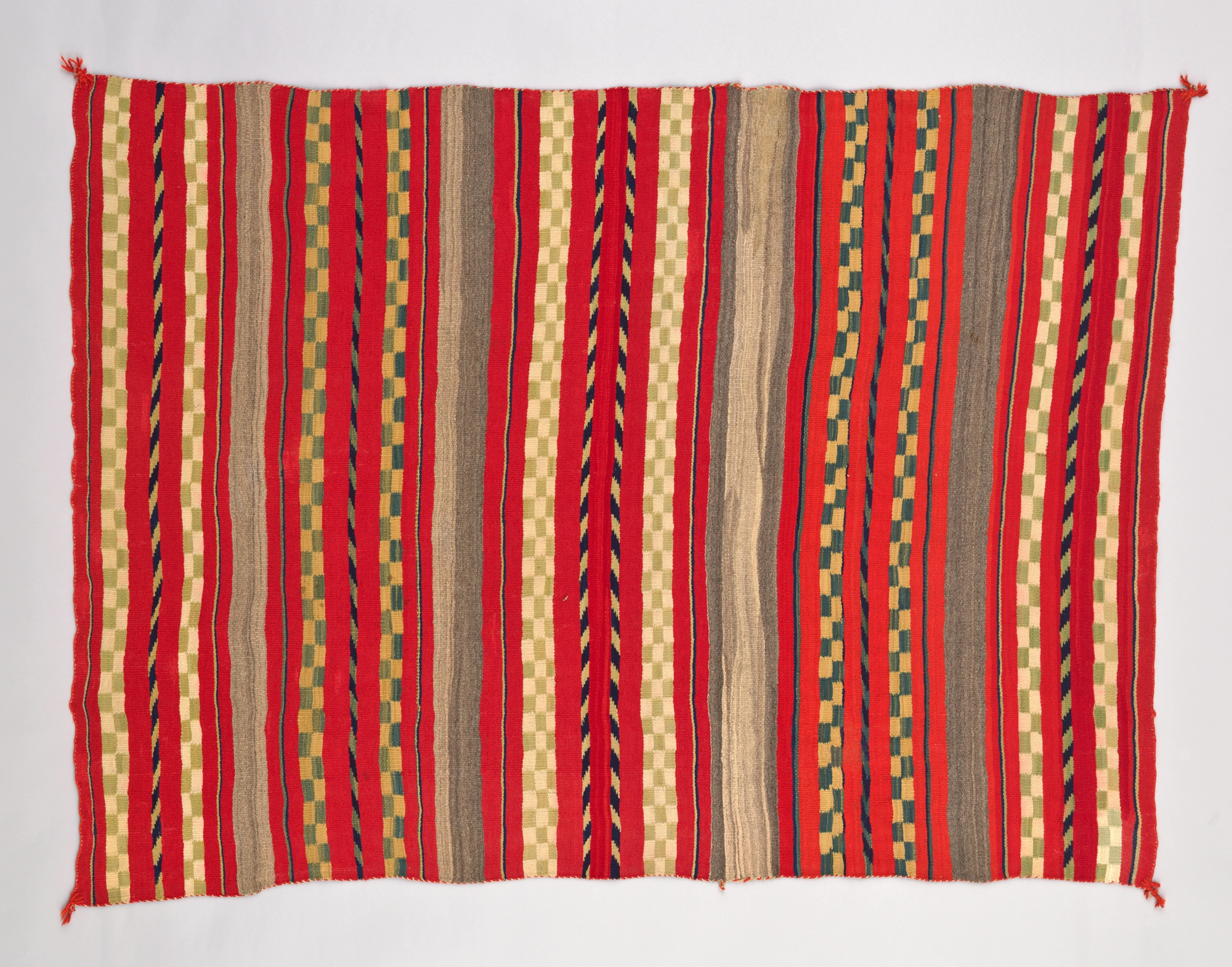
Serape with Compound Banded Design, ca. 1870–95, New Mexico. Medium: Natural and Germantown wool, plain weave and single interlocking tapestry weave; twined warp ends and selvages; looped and knotted augmented corner tassels; natural and synthetic dyes. Dimensions:. 186.7 × 137.8 cm (73 1/2 × 54 1/4 in.). Art Institute of Chicago, Illinois, USA.
«Some Navajo blankets carry what fifth-generation Navajo weavers Barbara Teller Pete and Lynda Teller Ornelas call a “memory”—a tendency to fold along creases formed by previous wear. When this sarape is displayed according to its memory, as if draped around a person’s shoulders, its striped and checkered lines form a new pattern.» (Art Institute of Chicago curators).

Chief's Blankets
Navajo Chief's Blankets are distinguished by several key characteristics:
- They were always woven wider than long (unlike serapes);
- They had designs that ran from edge to edge;
- They were worn draped over the shoulders but could be used as a bed cover at night;
- They possessed exceptional qualities: supple texture, warmth, and naturally waterproof. They were finely woven and tightly woven to repel water and keep the wearer warm and dry during cold, rainy, and snowy seasons.
- They were considerably lighter than buffalo skins while providing comparable warmth;
- They were also highly prized for aesthetic reasons.
They were not made exclusively for tribal leaders, nor did the Navajo themselves have chiefs. (The Navajo had no chief at all!). The name comes from the fact that these blankets were so valuable and expensive to make that only certain wealthy individuals could afford them. Among other tribes, such as the Utes and various Plains groups, these blankets were often owned by chiefs and high-status individuals, thus cementing their designation as Chief's Blankets".
Scholars have identified three distinct design phases in the evolution of Navajo Chief's Blankets; they constitute what is known as the "Classic Period."
First Phase (Hanoolchaadi) - ca. 1700-1830s
Navajo Chief's Blankets of the early period were woven with Navajo Churro sheep wool yarns and show the simplest design pattern: horizontal bands of intense, natural brown and white wool; they also incorporated three bands of thin stripes of red (cochineal) and/or blue (indigo). Archaeological and historical evidence shows that they existed before 1800. They are extremely rare today, with only an estimated 50-100 surviving examples. (The rarest can be valued at up to half a million dollars). The chief's blankets of this phase are also known as the "Ute style" because of their popularity among the Ute tribe, who preferred versions with brown and white bands and thin blue bands, but no red stripes.
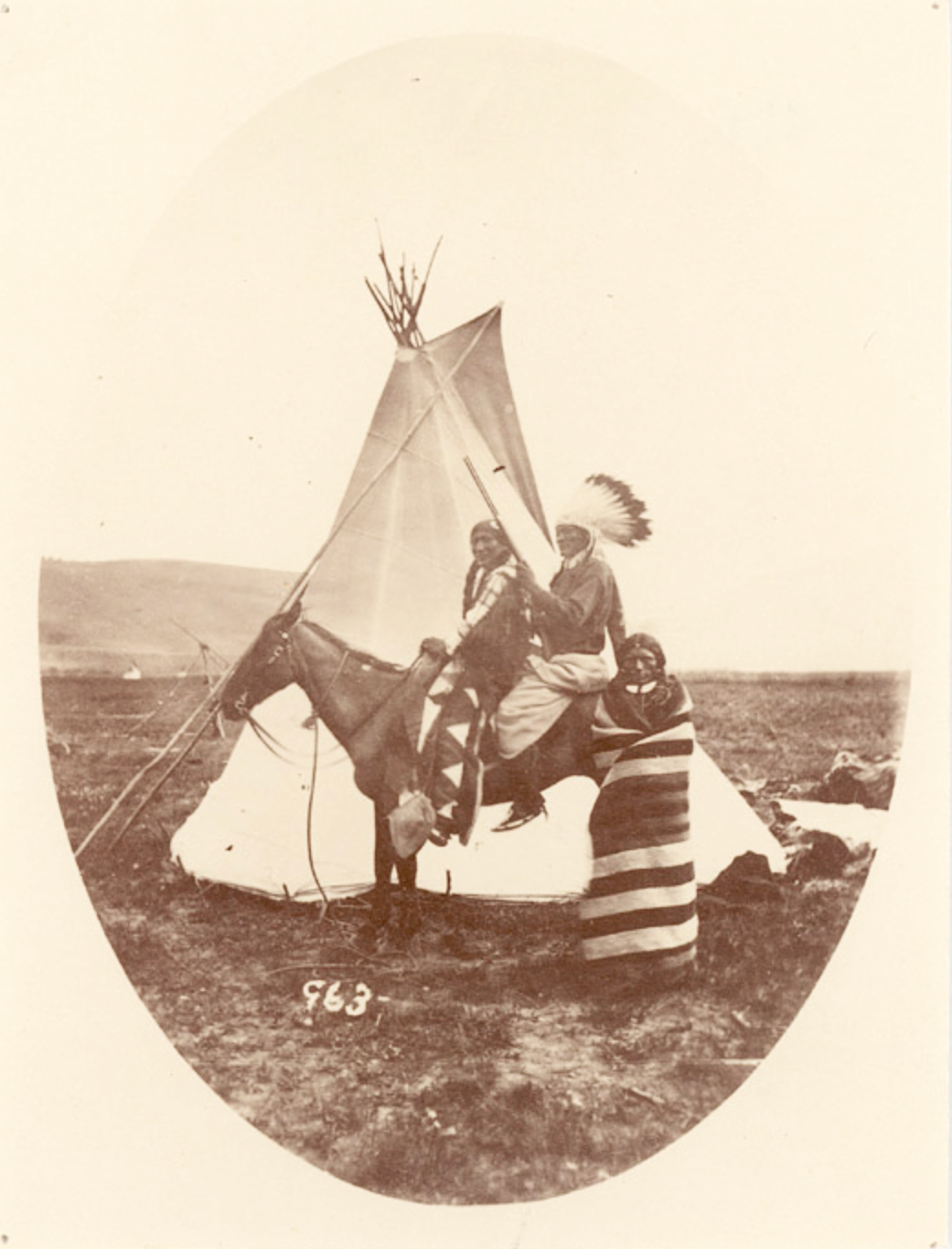
Ute Man wearing a Navajo/Diné first-phase Chief's Blanket. 1874, Los Pinos, Colorado. Photo by William Henry Jackson.
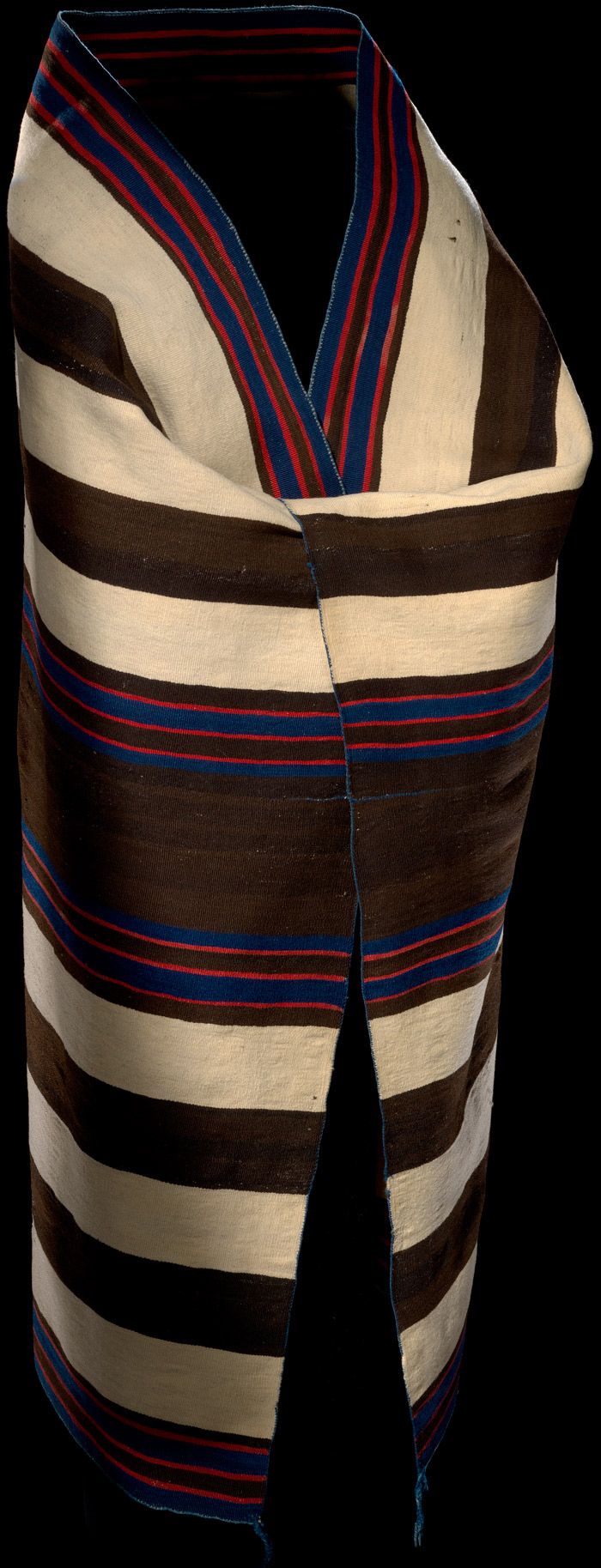
Diné (Navajo) first-phase chief blanket, ca. 1840–1850, New Mexico. Medium: Wool yarn, bayeta (unraveled wool cloth), dyes. Dimensions: 179 x 145 cm. Presented by S. W. Woodhouse, Jr.. On display at the The National Museum of the American Indian, Smithsonian, USA.
Navajo Ute First Phase Blanket, ca. 1850 | ANTIQUES ROADSHOW | PBS
Please note that today this First Phase Chief's Blanket is worth close to 2 million dollars.
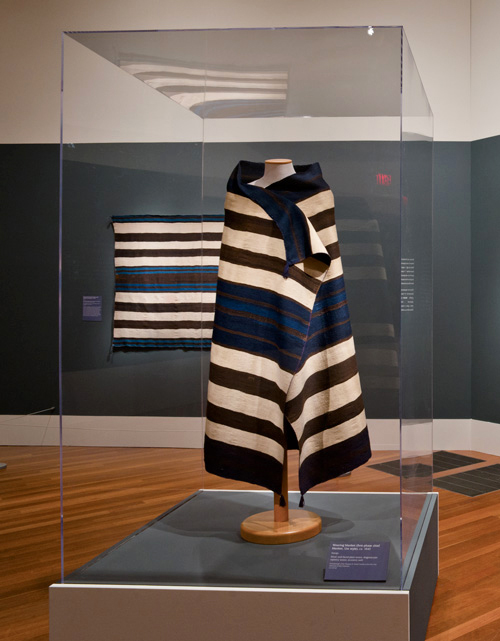
"Ute style" Chief’s Blanket, New Mexico, ca. 1830.
This valuable first-phase blanket was collected by George Horace Lorimer (1867-1937), editor-in-chief of the Saturday Evening Post, in the early 20th century. This piece, along with other valuable chief's blankets from the Weisel family collection, was displayed in an exhibition at the de Young Museum in San Francisco, California, in 2014. The exhibition was entitled Lines on the Horizon: Native American Art from the Weisel Family Collection, featured approximately 70 objects and textiles from the extraordinary collection recently donated to the museum.
Second Phase - 1840-1860
The Chief's Blankets of the Second Phase are similar to those of the First Phase but with additional design elements: twelve bars or rectangles were added to the three bands (four rectangles in each band); red yarns appeared either as horizontal rectangles or concentric squares. The blankets still maintain the wider-than-long format. «By the beginning of the second phase, the weavers had also begun to expand their color palette, adding yellow and green accents, for example. But one of the colors the Navajo weavers coveted most was the red of the prized bayeta cloth made in England and later in Spain and Mexico. They would unravel the cloth and then weave the material into rectangles on their blankets. The bayeta, which was occasionally used in first-phase blankets, became a color and cloth that Navajo weavers used extensively in the second phase. The bayeta was dyed with cochineal, named for the cochineal beetle. According to Tyrone Campbell (author of books on Navajo weaving and dealer in antique Navajo and Pueblo weavings in Scottsdale, Arizona), "It came in rich shades from pink to deep burgundy, and it's permanent. There is no plant in the Southwest that will give you such an intense red that won't fade".» (Navajo Chief's Blankets: Three Phases | Antiques Roadshow | PBS).
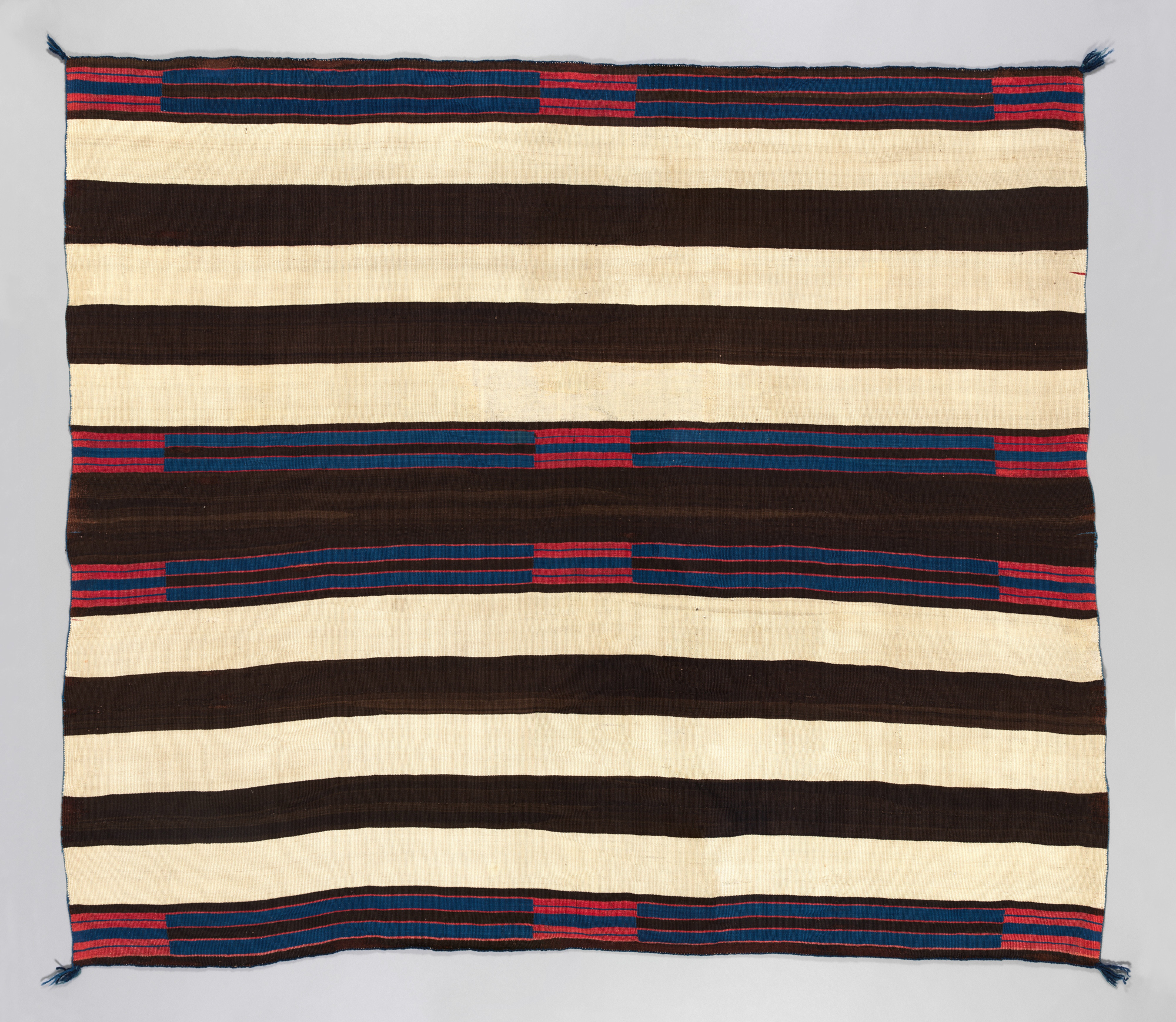
Second Phase Chief's Blanket by an unidentified Navajo artist; date: mid-19th century. Medium: Wool. Dimensions: 62 × 73 1/2 in. (157.5 × 186.7 cm). The American Wing of the MET Museum, New York, USA.
Navajo Second Phase Chief’s Blanket at the Met
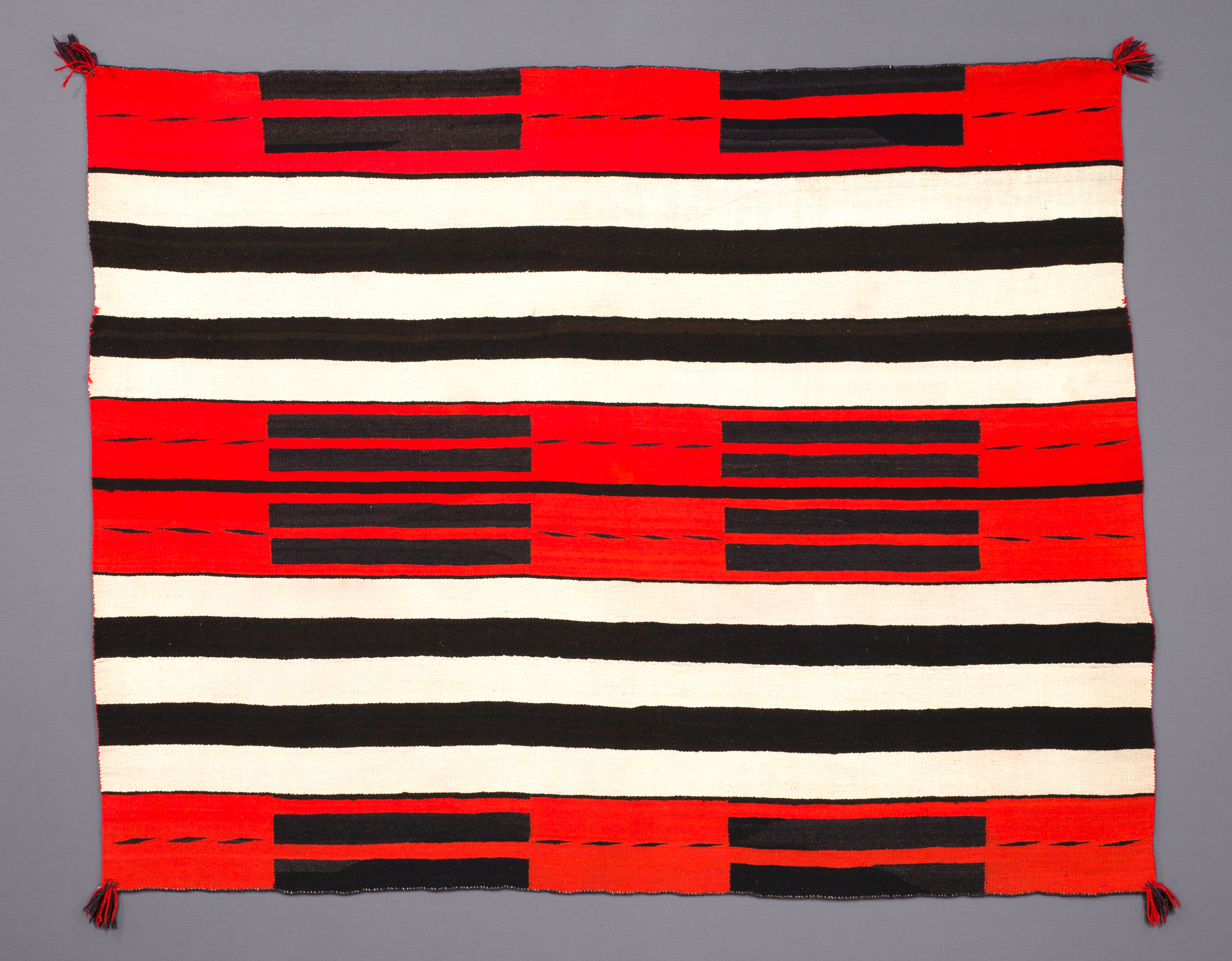
Second-Phase Chief'S Blanket, ca. 1880. Medium: Wool and dye. Dimensions: 55 1/4 × 71 1/4 in. (140.3 × 181 cm). Saint Louis Art Museum, Missouri, USA.
«In this blanket, charcoal-gray bars and dashes float on a red ground, establishing massive patterned bands that balance against the dominant white-and-black stripes. This type of textile captivated 19th-century Native peoples from the Plains and Mountain West, who valued these striking blankets not only for their unusual form and materials, but also because they originated far away, as is often the case with luxury items. Diné peoples traded blankets like this one with neighbors in the Pueblos of Pecos and Taos, centers for Native trade networks. Starting in the 1820s, American traders also transported blankets from the Southwest to a series of commercial forts across the Plains. By the late 19th century, when the railway brought waves of travelers to the Southwest territories, these blankets circulated in the developing national market for Native art. Thomas Dozier, an art and curio dealer based in the rail town of Española, New Mexico, displayed this blanket at the St. Louis World’s Fair in 1904.» (The Saint Louis Art Museum curators).
Third Phase - 1860-1868
The Chief's Blankets of the third phase show a rather elaborate design evolution. They are characterized by cross formations, concentric diamonds, half diamonds, and quarter diamonds in red yarn, and three bands overlaid by serrated or terraced diamonds or triangles. «These new designs featured elements of a “9-spot” design that covered the top, middle and bottom of each blanket with new, exciting patterns.» (Nizhoni)
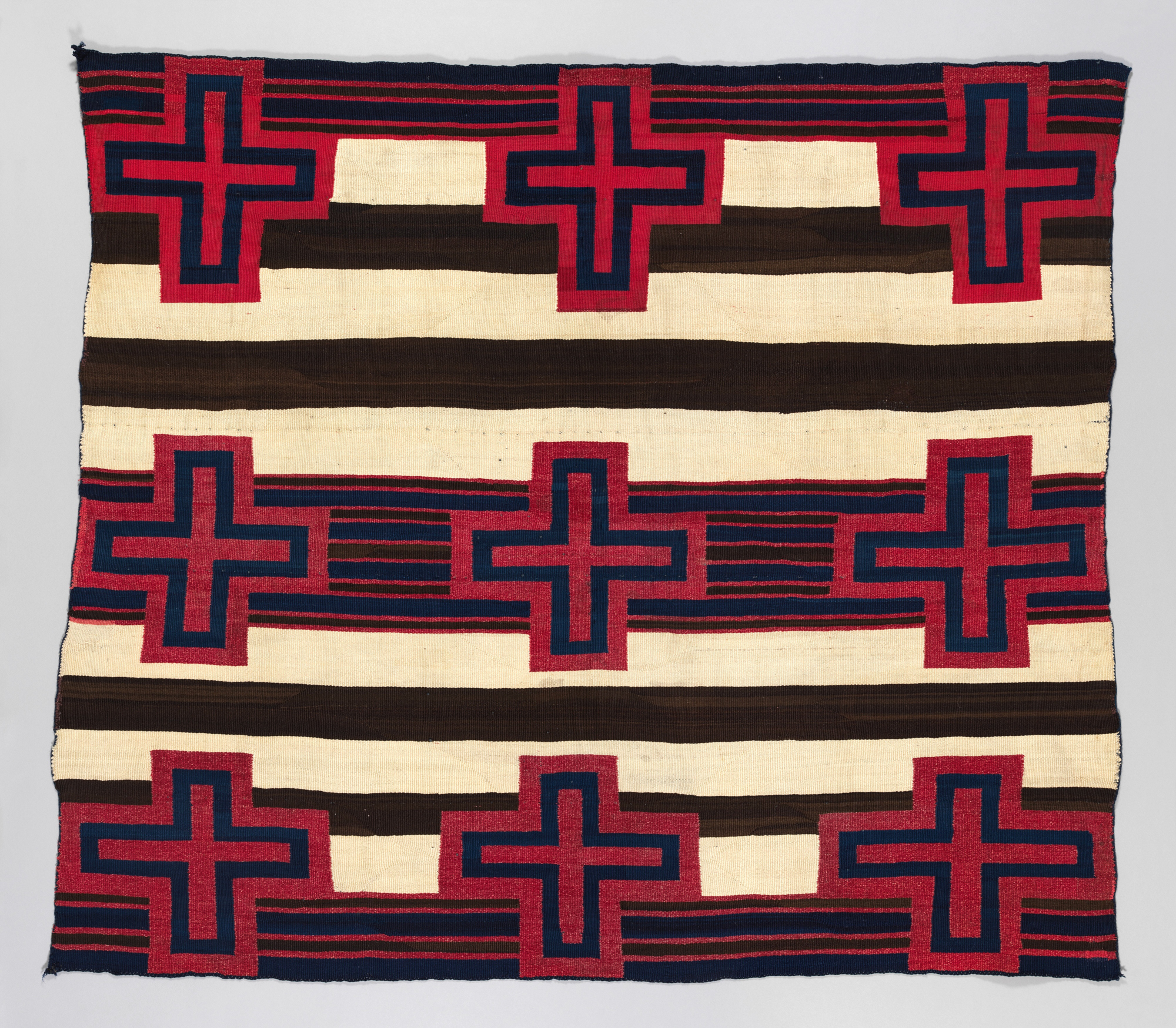
Third-Phase Chief's Blanket by an unidentified Navajo artist; date: 1865. Medium: Wool. Dimensions: 56 x 66 in. (142.2 x 167.6 cm). The American Wing of the MET Museum, New York, USA.

ABOVE: Third-Phase Chief's Blanket by an unidentified Navajo artist; date: 1865-70. Medium: Dyed and undyed wool. Dimensions: 47 3/4 x 66 1/2 in. (121.3 x 168.9 cm). The American Wing of the MET Museum, New York, USA.
BELOW is a similar Third-Phase Chief's Blanket (dimensions: 56 x 69 in., 142 x 175 cm) on a kind of simple mannequin. It dates from the 1870s-80s and is made of natural hand-spun wool in white and dark brown with indigo blue, raveled aniline, and cochineal dyed reds. It's for sale at the Toh-Atin Gallery, Durango, CO, USA.
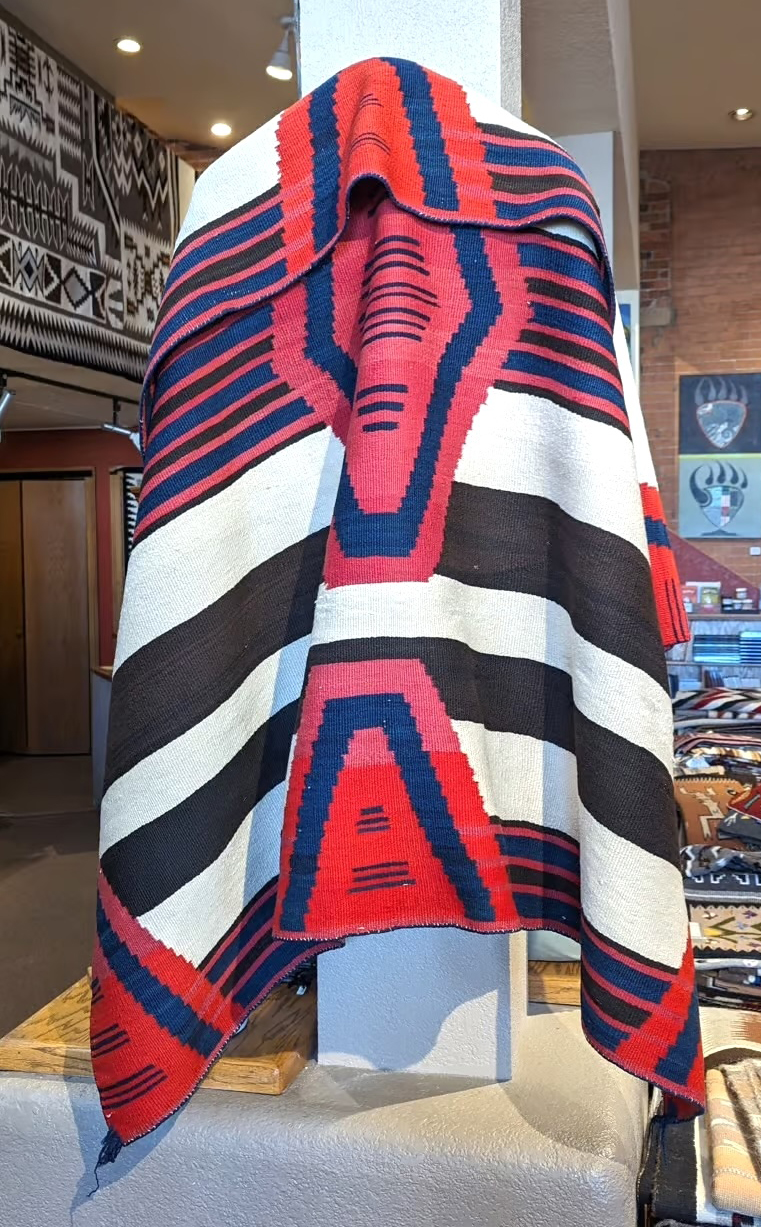

LEFT: Third-Phase Chief's Blanket, ca. 1880, New Mexico. Medium: Wool, dovetail tapestry weave with "lazy lines"; twined warp ends and and selvedges; corner tassels. Dimensions: 141 × 163.2 cm (55 1/2 × 64 1/4 in.). Art Institute Chicago, Illinois, USA.
RIGHT: Third-Phase Chief's Blanket, ca. 1880, New Mexico. Medium: Wool, plain weave with "lazy lines" and dovetail tapestry weave; warp and weft twine; corner tassels. 153.7 × 206.4 cm (60 1/2 × 81 1/4 in.). Art Institute of Chicago, Illinois, USA.
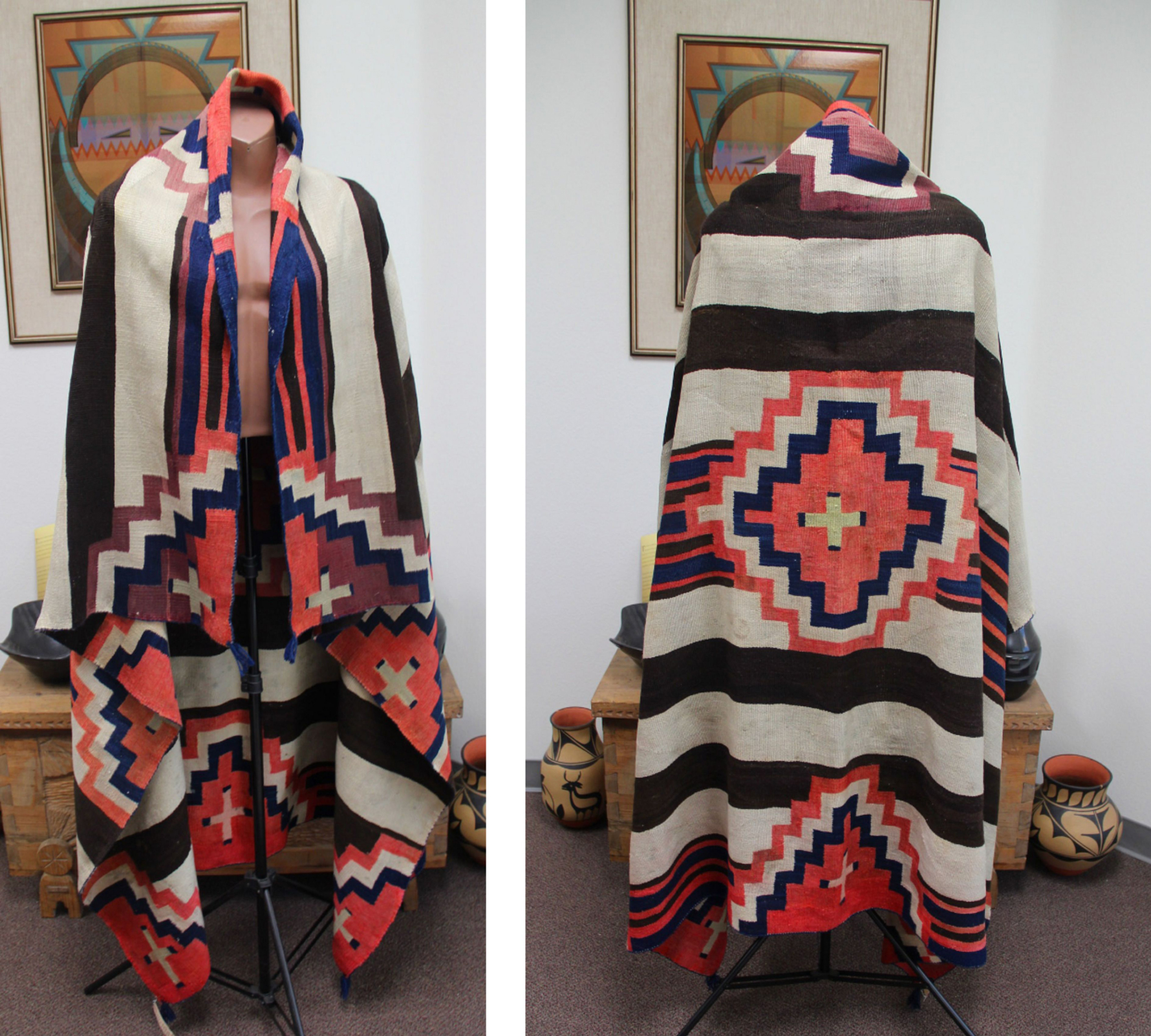
Rare Third-Phase Chief's Blanket, ca. 1860s-1870s. Len Wood's Indian Territory, Aliso Viejo, CA, USA.

The spread of the Chief's Blankets
Chief's Blankets became important trade items, especially from 1800-1830, among high-ranking members of various tribes including the Arapahoe, Cheyenne, Kiowa, Comanche, Lakota and Dakota Sioux, Shoshone, Blackfeet tribe, and Ute. These blankets were so closely associated with Navajo weavers that in some Plains languages, including Lakota and Apsáalooke (Crow), the term for the Navajo people translates as "those who make striped blankets".
« Traded and prized throughout the Southwest and Great Plains, these gorgeous weavings were not only valued for their horizontal stripes of rich Cochineal reds, Indigo blues and deep blacks, but because of their supreme quality.» (Nizhoni).
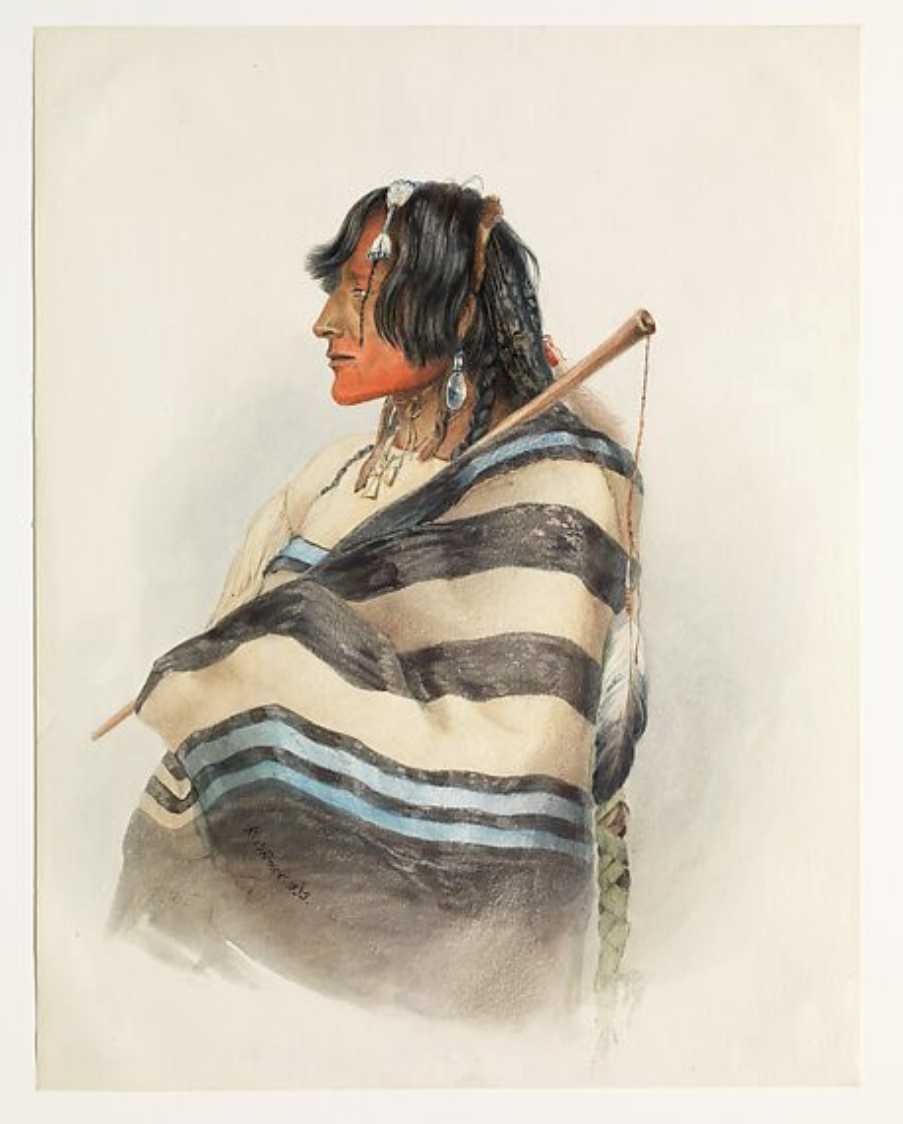
Kiäsax, Piegan Blackfoot Man, drawing by Swiss artist Karl Bodmer in 1833. Medium: Watercolor and graphite on paper. Dimensions: 12 3/16 x 9 1/2 in. The American Wing of The MET, New York, USA.
This 1833 work portrays a young man of the Piegan, the largest group within the Blackfeet Nation, wearing a First Phase Chief's Blanket. It was painted by Karl Bodmer, who was commissioned to record the Native Americans encountered by the German Prince Maximilian during his trek across the American West.
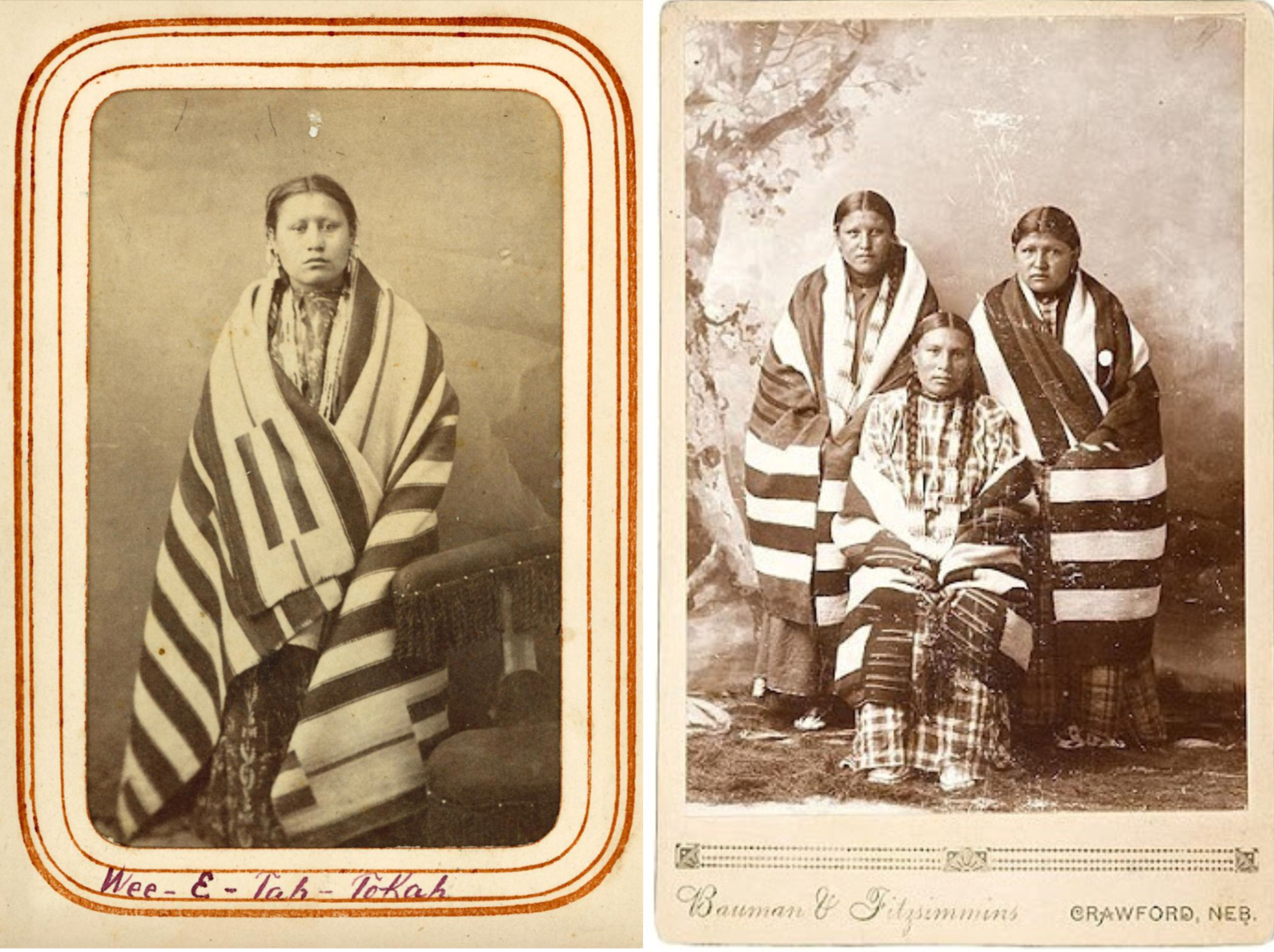
LEFT: Wee-E-tah-tokah, Dakota Sioux, photo by William R. Godkin, undated.
RIGHT: Oglala Lakota women wrapped in Navajo blankets; ca. 1890.
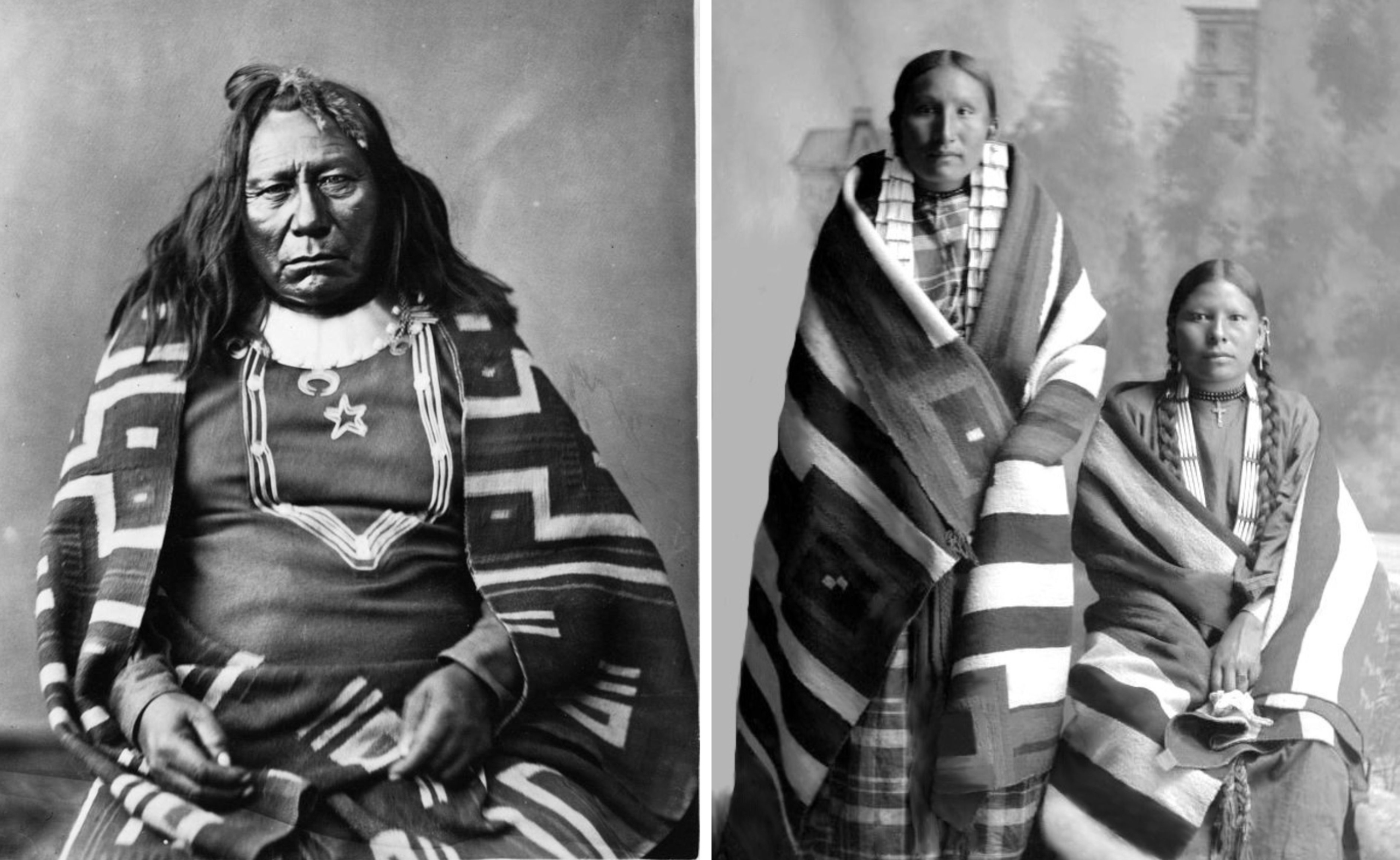
LEFT: Colorow, warrior and chief of a band of Utes, born a Comanche in 1810 and passed away in 1888. Photo by William Gunnison Chamberlain.
RIGHT: Two Lakota women, Pine Ridge Agency, South Dakota, 1891. Source: Denver Public Library, Western History, Genealogy Digital Collections, CO, USA.
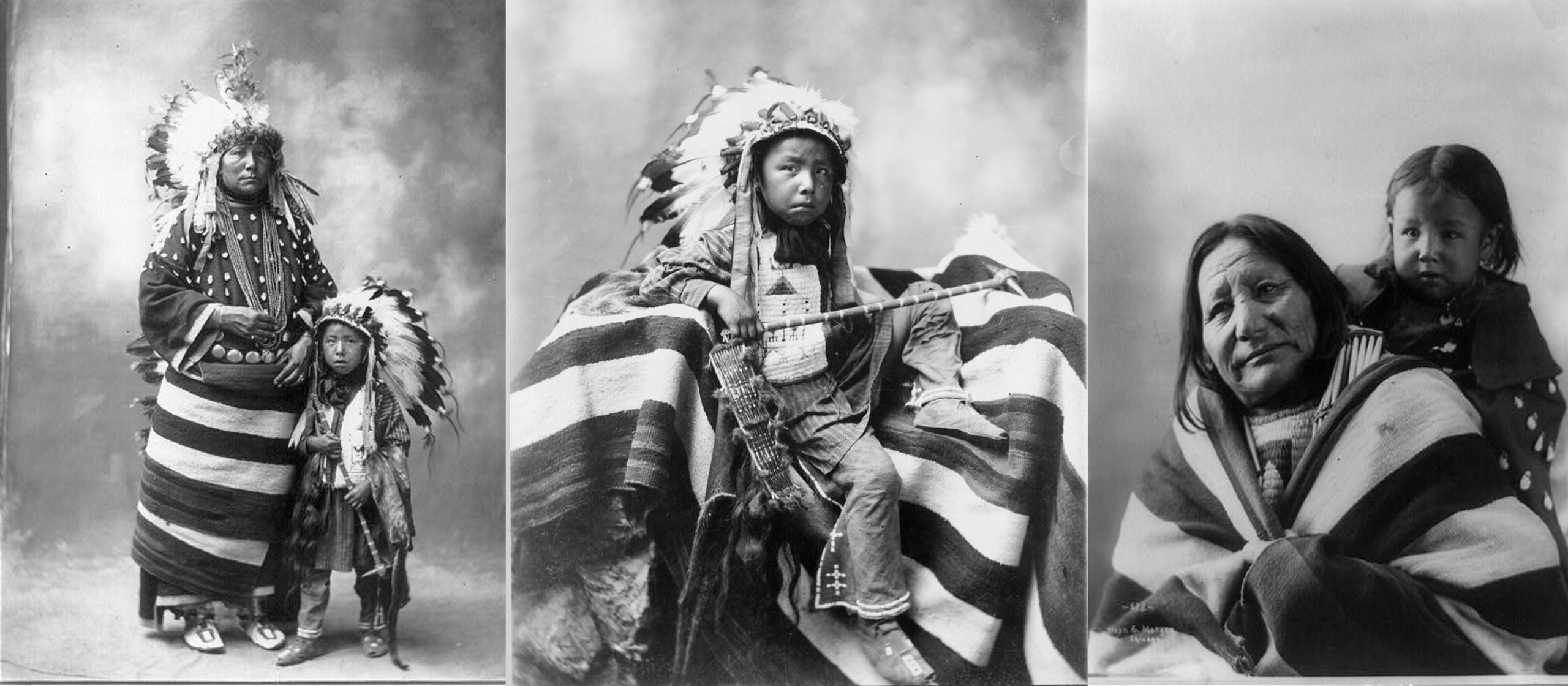
LEFT: Dolly Bird Head and Joseph Bird Head, full portrait, 1899. She was probably a Lakota woman; in the picture, she wears a S’ina Glega, a Diné blanket, wrapped around her waist. Photo by Heyn. Library of Congress Archives, USA.
CENTER: Joseph Bird Head, probably a Lakota child, 1899. Photo by Heyn. Library of Congress Archives, USA.
RIGHT: Chief Eagle Feather, probably a Dakota Sioux, with a baby, ca. 1900. Heyn & Matzen, Chicago. Library of Congress Archives, USA.
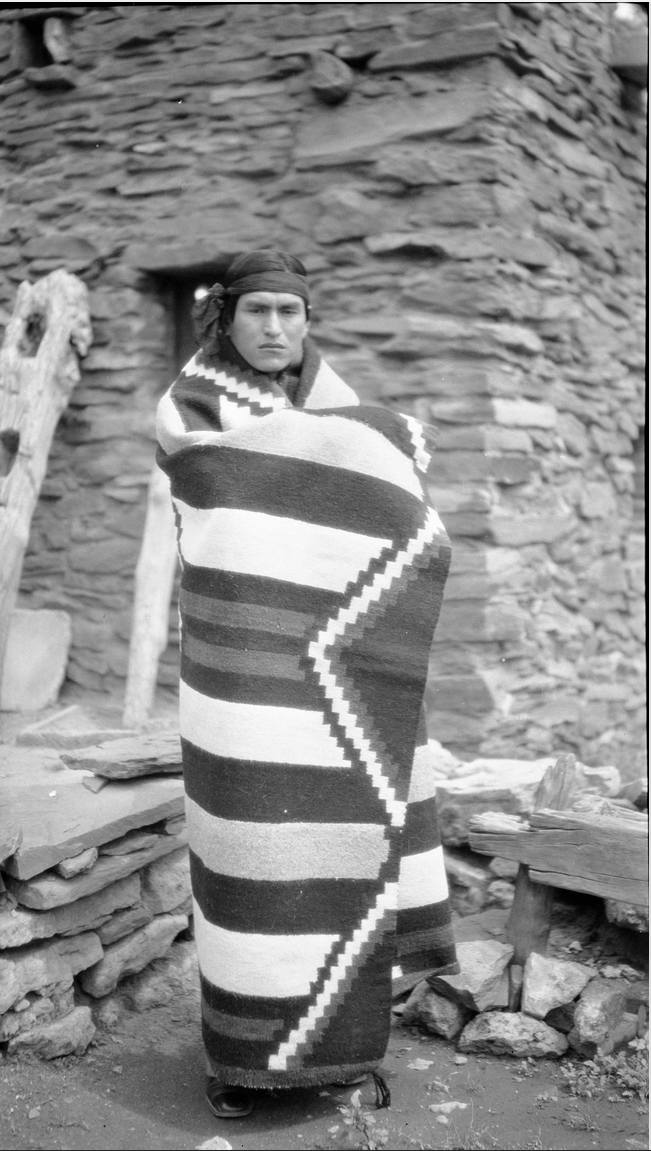
Hopi Homer Yoywatewa in an Old Navajo Chief's Blanket, Grand Canyon, AZ. Date: 1920s. Photo by Earle Robert Forrest. Arizona Memory Project, Museum of Northern Arizona, USA.
How much did a good-quality Chief's Blanket cost?
The search results indicate that a Navajo chief's blanket would have cost between $100 and $150 in 1860. That wasn't much money - it was a small fortune! To understand the extraordinary value of these blankets in the 1860s, consider that the average worker earned about $5 per week if he was lucky, with "laborers" earning about half that amount (about $2.50 per week). At $100-$150, a single chief's blanket represented about a year's wages for most men of the time. To put this in perspective, a house could be purchased for about $200 during this period. (Note that these figures have been confirmed by expert Tyrone Campbell).
After 1865, they became increasingly popular with Anglo-American collectors, and as a result, more Late Classic and Transitional Third Phase examples have survived than comparable serapes.
Later periods
Blankets woven after 1868 are referred to as the "Late Classic" period, which later gave way to the "Transitional Period" of the 1880s and 1890s.
The period from 1868 to 1880 marked a transitional period in Navajo weaving. Several technological developments influenced this transition:
- The invention of aniline dyes in England in 1856 reached the Southwest via the Santa Fe Railroad around 1865;
- Three-ply dyed yarn was imported from Germantown, Pennsylvania, that same year;
- Germantown was producing four-ply dyed yarn by 1875.
These developments led to the Eye Dazzler Period (1880-1900), characterized by brighter, more vivid colors in Navajo blankets as weavers adopted commercial Germantown yarn from Pennsylvania. Designs became more complex and colorful as new materials, dyes, and influences were incorporated into the Navajo weaving tradition.
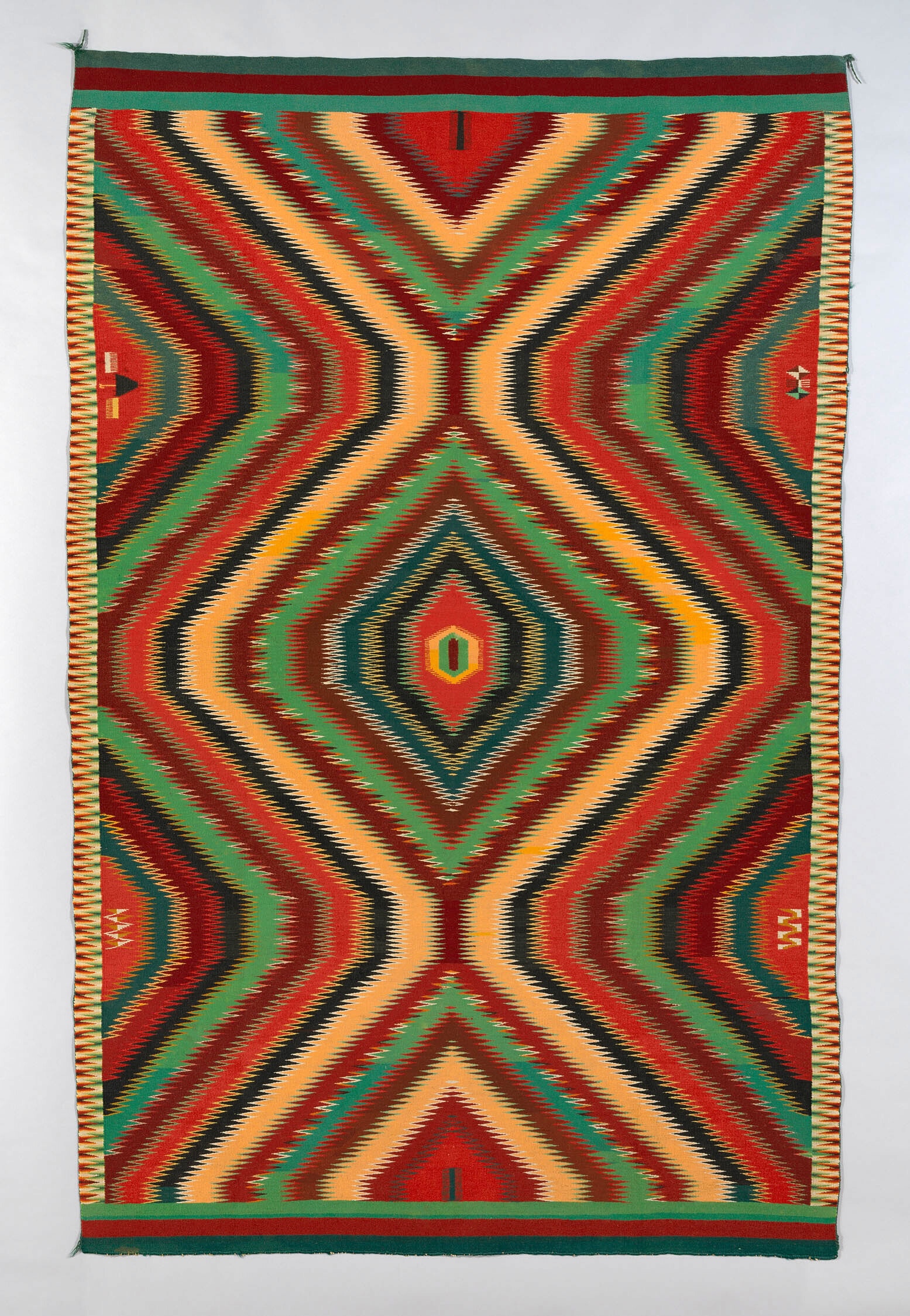
“Eye-Dazzler” Blanket, 1880–1899. Medium: Cotton and wool, single interlocking tapestry weave; twined selvages and heading, overcast finish terminating in tassels. Dimensions: 233 × 151.1 cm (91 3/4 × 59 3/8 in.. Art Institute of Chicago, Illinois, USA.
«Brillant color and bold overall patterns with serrated diamonds, chevrons, and interlocking lines are hallmarks of the “Eye Dazzler” style of Navajo (Diné) textiles produced from the late-19th to the early-20th century. Earlier Navajo blankets featured broad horizontal bands of indigo blue, white, dark brown, black, and red, subsequently enhanced with the addition of small diamonds, bars, and squares. The lively approach of Eye Dazzler weaving developed out of a period of major cultural and artistic transformation beginning in 1864 when the U.S. government forcefully resettled the Navajo in the Bosque Redondo reservation. From the early 1860s, the Navajo received brightly colored commercial yarns as part of their U.S. government annuities. The new Eye Dazzler weaving also incorporated design elements characteristic of Mexican Saltillo blankets, which featured serrated diamonds and zigzag lines.
The creator of this blanket fully utilized the intense color of commercially dyed yarns and the Saltillo style to create a spectacular work. Internlocking serrated undulating lines appear to vibrate over the entire surface. The vivid interplay of red and orange hues with brillant blues, greens, yellow, white, and black produces an energetic, three-dimensional illusion.» (The Art Institute of Chicago curators).
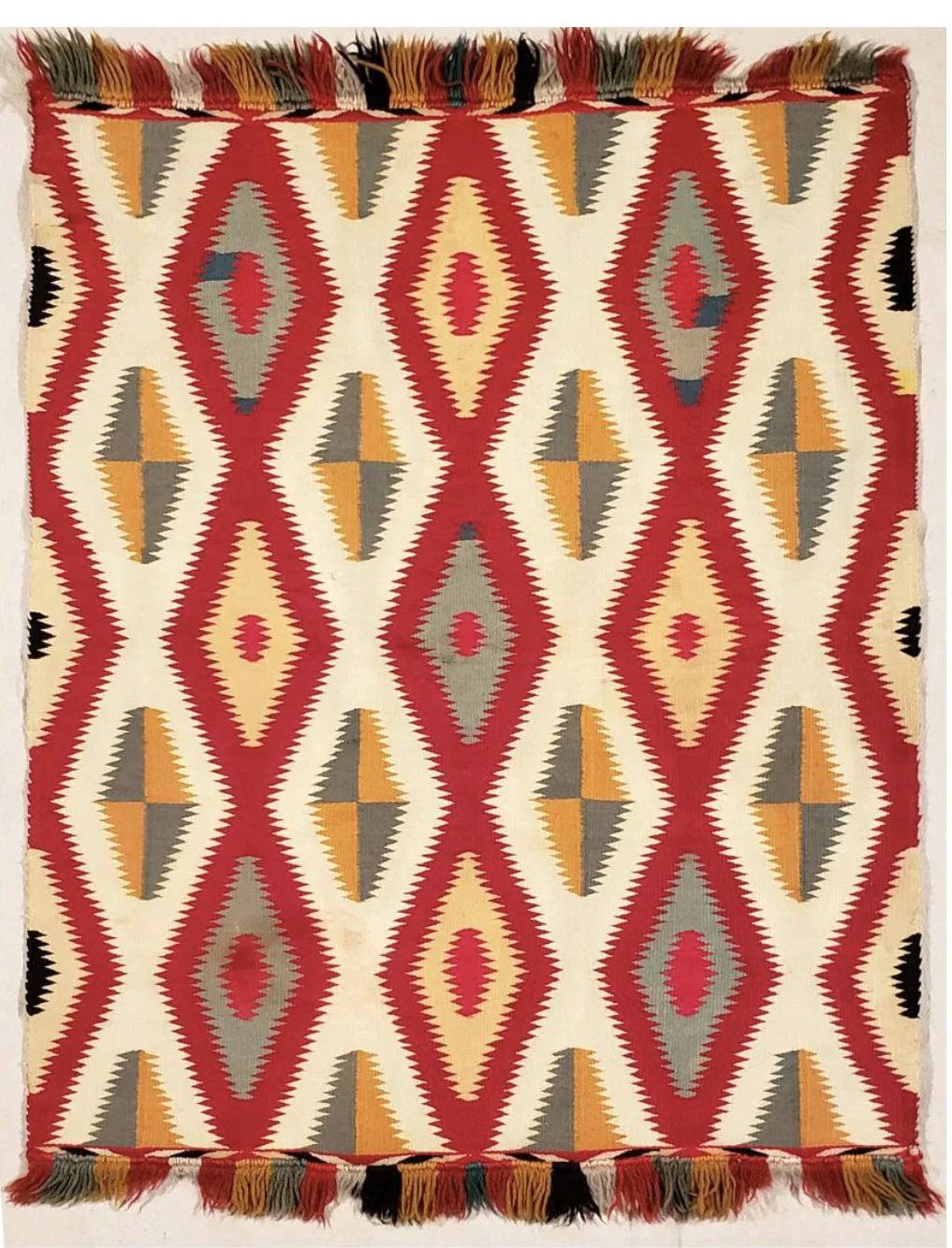
Germantown Saddle Blanket, ca. 1900-1910. Dimensions: 34 x 25 in. / 86.4 x 63.5 cm. Sold at auction in 2020 by Antiques From Estates - Michael & Sophie Coe.

Germantown Eye-Dazzler (Dah’iistł’ó) Blanket, ca. 1885. Medium: Dyed wool and cotton. Dimensions: height: 83.25 in, 211.455 cm; width: 64 in, 162.56 cm. Source: Indigenous Arts of North America, Denver Art Museum, CO, USA.
«The "Eye Dazzler" style was popular with weavers and their customers from about 1880 to 1900 when brightly colored commercial yarns were widely available through newly established trading posts on the Navajo Reservation.» (The Museum curators).

“Germantown Eye-Dazzler” Rug, New Mexico, before 1890. Medium: Cotton and wool dovetailed tapestry weave. Dimensions: 220.2 × 155.3 cm (86 3/4 × 61 1/8 in.). Art Institute of Chicago, Illinois, USA.
«The creator of this blanket fully utilized the intense color of commercially dyed yarns and the Saltillo style to create a spectacular work. Internlocking serrated undulating lines appear to vibrate over the entire surface. The vivid interplay of red and orange hues with brillant blues, greens, yellow, white, and black produces an energetic, three-dimensional illusion.» (The Art Institute of Chicago curators).
The masterpiece above is not a blanket, but a rug. In the late 19th and early 20th centuries, rugs and carpets became the most successful Navajo/Diné textiles, taking on the artistic and economic importance that blankets had held for decades. We will discover not only how and why this happened, but also how Navajo textile art evolved to produce masterpieces of absolute beauty.

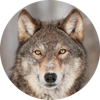
Alyx Becerra
OUR SERVICES
DO YOU NEED ANY HELP?
Did you inherit from your aunt a tribal mask, a stool, a vase, a rug, an ethnic item you don’t know what it is?
Did you find in a trunk an ethnic mysterious item you don’t even know how to describe?
Would you like to know if it’s worth something or is a worthless souvenir?
Would you like to know what it is exactly and if / how / where you might sell it?